The Era of Foldable Phones Has Arrived
Foldable phones have seemingly been just around the corner for years—prototypes were dangled temptingly in front of the public at CES 2019 (the Royole FlexPai) and product videos proliferated online. But now multiple manufacturers are releasing foldable smartphone products to the mass market. Some of these new models were on display at the recent C-TOUCH & DISPLAY SHENZHEN 2020 expo in China—which fit nicely with the theme of this year’s show: “Usher in a Foldable Era.” C-TOUCH is one of the largest tech tradeshow events in Asia, this year drawing more than 700 exhibitors and 31,000+ attendees.

Global shipments of foldable phones are expected to take off rapidly, with some industry experts predicting as many as 10 million units shipped by the end of 2021.1 Major brands including Samsung Electronics, LG Electronics, Asustek Computer, and Lenovo have all been getting new foldable display products ready for release.
Obstacles on the Path to Foldable Devices
Typically, foldable phones rely on flexible, active-matrix OLED (AMOLED) screens. AMOLEDs are thin, light, and flexible in part because they don’t require a rigid backlight, making them the top choice for many innovative smartphone brands. Challenges with attaining cost-effective, high-yield OLED manufacturing have slowed the emergence of viable foldable phones for the mass market, however.
The production challenges for flexible vs. rigid OLED displays are a bit different, encompassing multiple aspects and components of the device: “equipment, substrate, backplane, emitting layer, color patterning, encapsulation, touch panel, and cover windows.”2 Flexible displays require different approaches to the substrate and carrier glass, encapsulation method, cutting, and touch-sensor patterning. Even manufacturers who have been successful at achieving desired display quality with rigid OLED have been challenged by these aspects of flexible display production.
Another stumbling block has been the fact that all components of the phone—not just the OLED display itself—must be equally flexible— for example, the cover screens. Rigid phones typically use glass covers, which provide a crystal-clear image and lasting durability. But traditional glass screens don’t fold. While plastic screens provide the flexibility to bend and fold, they scratch easily and don’t provide the same clarity as glass screens. The race to develop foldable phones was in part a race to develop more flexible glass and glass-like materials to use as the cover layer.
Hot New Foldable Phone Models
Materials innovations have addressed many of these challenges, and as such, foldable device screens are finally here. One of the first foldable phones released to market in 2020 was the Motorola Razr 5G—a design throwback to the popular Razr flip phone of the early aughts, now with a continuous foldable interior display screen. Another early foldable phone released to market was from Samsung, the Galaxy Z Fold. Samsung reportedly plans to release three new foldable phone models in 2021.3
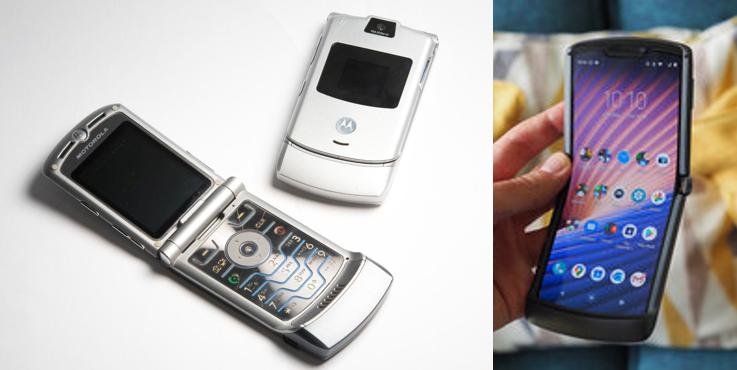
The original Motorola Razr flip phone released in 2004 (left), the latest generation clamshell-style foldable Razr 5G of 2020 (right). (Images © Motorola).
Some phones billed as “foldable” displays actually consist of two individual screens facing each other, mounted on a hinged casing, such as the LG Velvet and Microsoft Surface Duo. But users who want a continuous, seamless image will seek display panels that bend and fold.
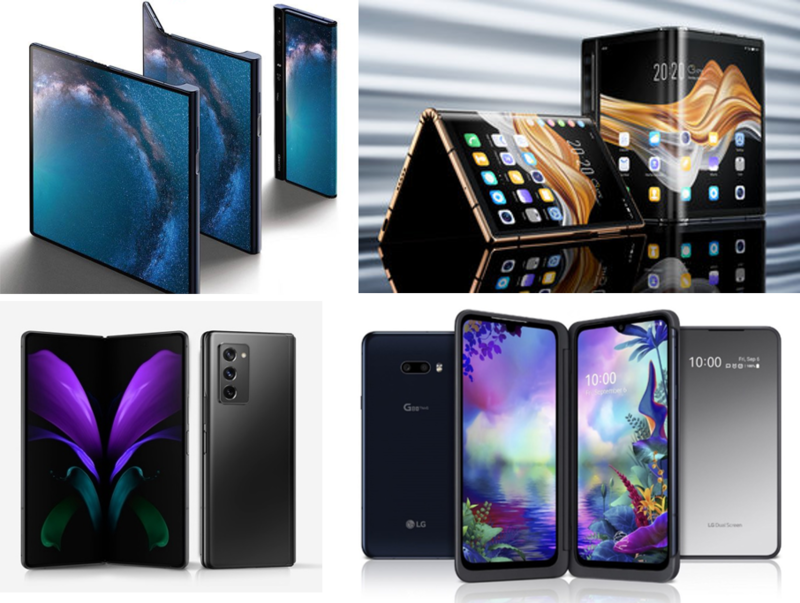
The Huawei Mate X foldable (top left) and the Royole Flex Pai 2 (top right) both take advantage of folding display technology to expand the amount of screen real estate compared to the size of a traditional smart phone. The Samsung Galaxy Z Fold2 (bottom left) and the LG G8X ThinQ (bottom right) show examples of a single folding display and a dual-screen device. (Images © Huawei, Royole, Samsung, and LG Display, respectively)
Meanwhile, the next smartphone form factor innovation is already on the horizon: rollable screens like the one in development by Chinese company Oppo: The Oppo X 2021. While still in prototype stage, this rollable screen model is billed as eliminating the “crease” issue of foldable screens.4
Display Quality Inspection Solutions
Members of Radiant’s China teams were at this year’s C-TOUCH event. In the Radiant booth, they demonstrated our display measurement and AOI (automated optical inspection) solutions that can help manufacturers ensure the quality of flat-panel, curved, and foldable devices, including those with OLED and microLED displays.
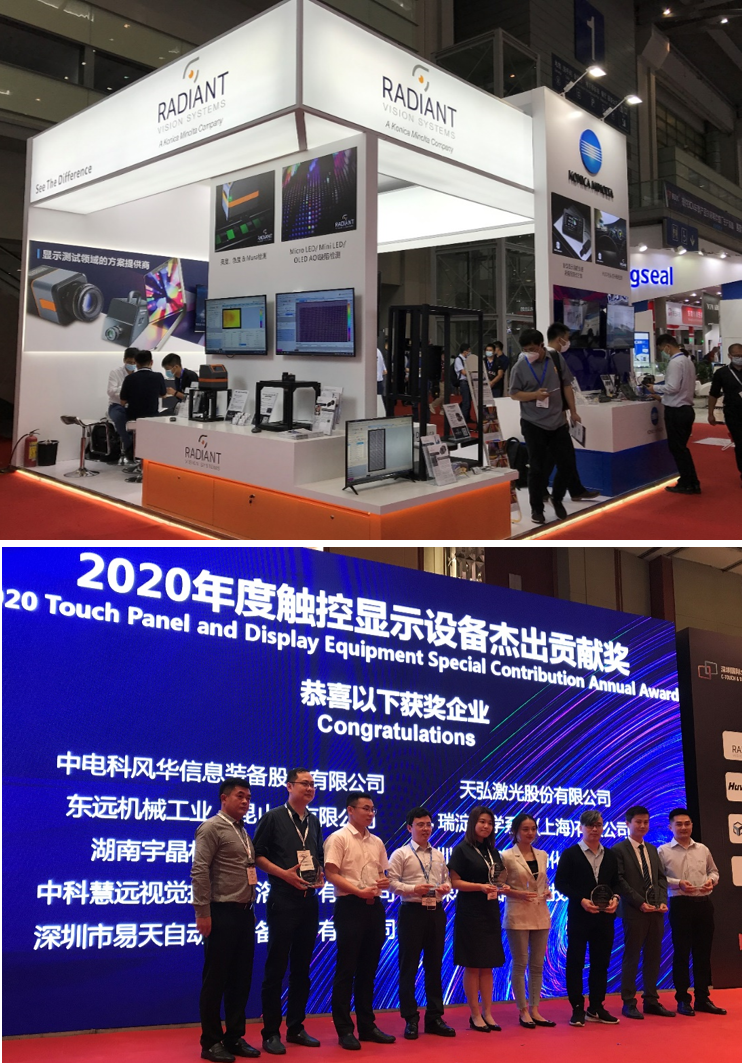
Radiant’s booth at C-TOUCH (top), which was shared with our sister company Konica Minolta China – Sensing Business Division; Radiant accepting a 2020 Outstanding Contribution Award for Touch Display Devices (bottom) from the C-TOUCH event organizers.
Radiant’s solutions for pixel- and subpixel-level measurement and correction rely on our ProMetric® Imaging Photometers and Colorimeters. Each ProMetric imaging system strikes a balance between capturing high-resolution images with low noise to provide high dynamic range for the most accurate measurement of tiny light-emitting elements. High-resolution ProMetric systems are able to characterize all pixels of a display at once, in precise detail, at production line speed.
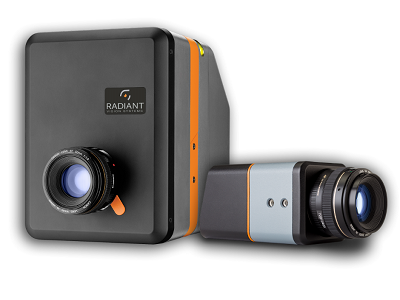
Radiant ProMetric® I-Series Imaging Colorimeter (left) and Y-Series Imaging Photometer (right).
Powered by our TrueTest™ software, Radiant solutions are helping OLED device manufacturers to identify defects (at the subpixel level) and non-uniformity (such as mura) to ensure a perfect viewing experience for all display customers. Once defects are identified and analyzed, Radiant’s demura method can be used to correct and calibrate uniformity in emissive displays (OLED, mini-, and microLED) to increase yields. Radiant’s proprietary demura method accomplishes highly accurate display pixel registration, measurement, and correction using state-of-the art image processing techniques and patented software algorithms.
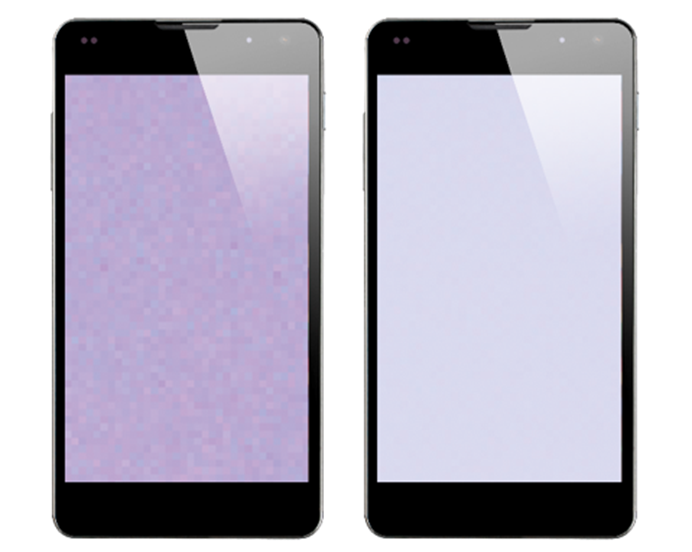
An example showing actual measurement images of an OLED phone display before (left) and after (right) demura correction.
CITATIONS
- Wang, M., et al. “Global foldable phone shipments may reach 10 million in 2021,” Digitimes, July 24, 2020.
- Hsieh, D., “The challenges of manufacturing AMOLED foldable displays”, OMDIA, August, 2018
- Sarwar, N., “Samsung to launch three types of foldable phones in 2021, says OLED research body”, PocketNow, December 4, 2020.
- Tung, L., “Meet the expandable phone: Here’s how Oppo’s rollable display solves crease problem”, ZDNet, November 18, 2020.
Join Mailing List
Stay up to date on our latest products, blog content, and events.
Join our Mailing List
